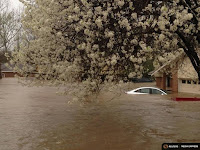When the skies open up and deluge an area, the results can be catastrophic, with roads washed out and homes destroyed by the resulting flash floods. Such extreme downpours are already occurring more often across the U.S., but a new study finds that as global temperatures rise, storms could dump considerably more rain and skyrocket in frequency.
The study, detailed Monday in the journal Nature Climate Change, suggests that storms that now occur about once a season now could happen five times a season by century’s end, a 400 percent increase.
And when such storms do occur, they could produce up to 70 percent more rain. That means that an intense thunderstorm that would today drop about 2 inches of rain would drop 3.5 inches in the future.
Such massive amounts of rain occurring more often could put significant strain on infrastructure that already struggles to deal with heavy rainfall, as seen across the country this year in places from Louisiana to West Virginia.
“I think this is one of the most severe consequences of climate change, at least in the U.S.,” study co-author Andreas Prein, of the National Center for Atmospheric Research in Boulder, Colo., said.
Heavy downpours have already increased across the entire continental U.S., according to the 2014 National Climate Assessment, mostly notably in the Northeast, where they have risen by 71 percent.
Read more at Warming U.S. Could See Extreme Rains Increase Fivefold

No comments:
Post a Comment